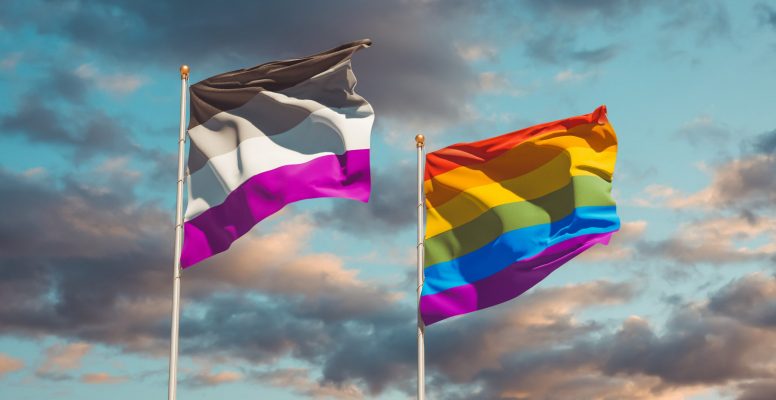
Asexuality: An Explainer
Written By: Tucker Chopp, Clinical Intern at ACS, Outlet Program
what is asexuality?
Broadly speaking, it refers to folks who do not experience sexual attraction to others. “Asexual” or “Ace” is often used as an umbrella term to refer to people who consider themselves to be included in the asexual community. A lack of sexual attraction is the uniting feature in this community.
What is the split attraction model and how does it relate to being asexual? To better understand those who are ace-identified (AKA aces), as well as attraction in general, it helps to distinguish between sexual and romantic attraction, i.e., use the split attraction model. The majority of people experience sexual and romantic attraction to the same people, e.g., most straight people are also heteroromantic. But for aces, it is less common for their sexual and romantic attractions to align and they may experience one type of attraction without the other. Folks who are aromantic (AKA aros) do not experience romantic attraction, and folks who are asexual do not experience sexual attraction. There are aces who are both asexual and aromantic. The split attraction model also applies broadly; anyone can experience sexual and romantic attractions that do not coincide, e.g., a pansexual may also be homoromantic.
And what’s this I hear about demisexual and panromantic? Many aces combine prefixes, like homo-, hetero-, bi-, pan-, or demi-, and the suffixes -romantic and -sexual to further specify their ace identity and to whom they do or do not experience an attraction. For example, someone who identifies as a panromatic asexual feels romantic attraction for others regardless of gender but does not experience sexual attraction. An aromantic heterosexual does not experience romantic attraction but does feel sexual attraction to those on the other side of the gender binary.
Can I have some more fast facts about asexuality? Absolutely!
- Asexuality is NOT the same as celibacy.
- Some ace people are averse to sex and actively avoid it. However, there are also plenty of aces who choose to have sex as well.
- Aces who are Grey-A or grey-asexual experience very limited sexual attraction or only experience it under specific circumstances.
- Demisexuals only experience sexual attraction to a person after a close personal bond has been formed with that individual.
- Asexuality is a sexual orientation just like how gay, bisexual, straight, pansexual, etc. are all sexual orientations.
What should I keep in mind when supporting an ace person? One study suggests that asexual-identified men and women have higher rates of interpersonal problems and mental health problems—such as issues with depression, anxiety, psychoticism, and suicidality—than heterosexual and gay/lesbian/bisexual individuals (Yule, Brotto, & Gorzalka, 2013). The same study notes that asexuals face prejudice and societal pressure to be heterosexual, i.e., the same social forces that hurt gays, lesbians, and bisexuals. So, in understanding and supporting an asexual person it helps to recognize that there is a good chance that they are facing some challenges in their mental health and relationships in the midst of dealing with societal pressure.
Here are some more general recommendations:
- Believe someone when they tell you they are asexual. When that happens, acknowledge that it took some courage to share that beautiful part of them. Saying something like, “thank you so much for trusting me enough to share that” or “I love you and I’m glad I get to learn even more about you!” can be a welcoming and supportive response to someone coming out as asexual.
- Be open and welcoming if an asexual person wants to tell you more about what language they use to describe themselves. Coming to terms with our identities and discovering what words describe ourselves best is an individual adventure and letting other people in on that process can be another stage in coming out.
- Make no assumptions about the experiences or histories of ace individuals. Remember that many ace individuals choose to be in relationships and/or have sex. Some aces experience sexual attraction in certain circumstances.
- Validate the struggles of asexual folks. Living as an ace in a largely sexual world can feel very isolating. The pressure to engage in a sexual and romantic relationship can feel monumental.
- Remember that asexuality is just one aspect of identity. Focusing too much on someone’s sexual orientation, e.g., attributing all their problems to their experiences as an ace, makes it harder to see them as a whole person who is much more than their sexual preferences or lack thereof.
- Spend some time on the Asexual Visibility & Education Network website (https://www.asexuality.org/en/), one of the biggest online ace communities, to learn more.
Works Cited and Consulted
Asexual. The Trevor Project. (2020, October 7). https://www.thetrevorproject.org/trvr_support_center/asexual/.
Forums. Asexual Visibility and Education Network. https://www.asexuality.org/en/.
Houdenhove, E., Enzlin, P., Gijs, L., & Van Houdenhove, E. (2017). A Positive Approach Toward Asexuality: Some First Steps, But Still a Long Way to Go. Archives of Sexual Behavior, 46(3), 647–651. https://doi.org/10.1007/s10508-016-0921-1
Morris, L. (2020, October 24). Six ways to be an ally to asexual people. Stonewall. https://www.stonewall.org.uk/about-us/news/six-ways-be-ally-asexual-people.
Yule, M., Brotto, L., & Gorzalka, B. (2013). Mental health and interpersonal functioning in self-identified asexual men and women. Psychology & Sexuality, 4(2), 136–151. https://doi.org/10.1080/19419899.2013.774162
*Special Thanks to Nat Bricker for their help revising this blog post!! And thanks to Kae Papula for their help too!*
